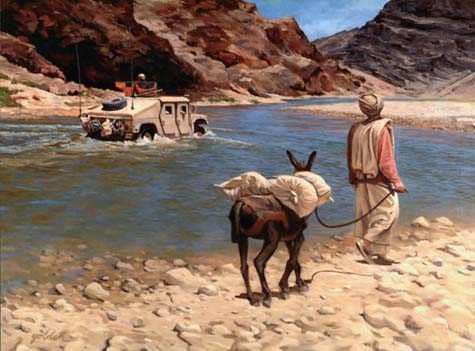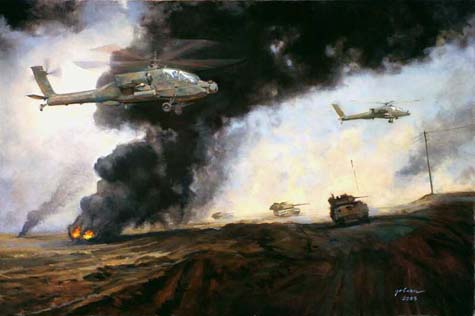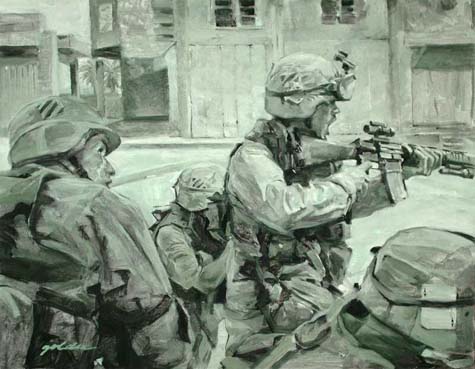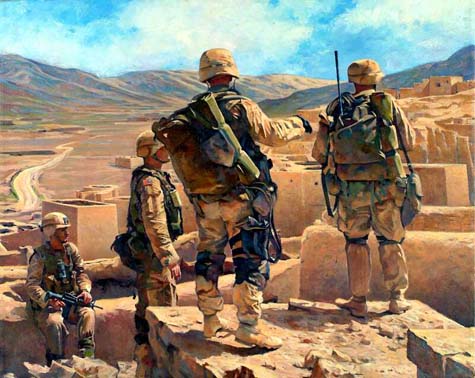Here is the latest edition of
my column at Foreign Policy:
Afghanistan and civil-military relations
General Stanley McChrystal's report on the situation in Afghanistan is likely to strain relations between the Obama administration and the uniformed military. The arrival of McChrystal's report in Washington in likely to spark its own low-level war of finger-pointing and blame-shifting between civilian policymakers in the White House and McChrystal's staff and defenders in the Pentagon. This strain in civil-military relations could last through the duration of the U.S. military's involvement in Afghanistan and beyond.
McChrystal's report is supposedly secret, but anonymous staffers have already revealed its themes to the Washington Post. The goal of these staffers is to protect McChrystal and the uniformed military against White House officials they likely don't trust. These staffers have evidently concluded that they need to leak first in order to establish their position and put White House staffers on the defensive.
The first task for McChrystal's report (and its leaking defenders) was to show how President Barack Obama's supposedly limited war aims actually result in broad, expensive, and open-ended goals for Afghanistan:
Although the assessment, which runs more than 20 pages, has not been released, officials familiar with the report have said it represents a hard look at the challenges involved in implementing Obama's strategy for Afghanistan. The administration has narrowly defined its goal as defeating al-Qaeda and other extremist groups and denying them sanctuary, but that in turn requires a sweeping counterinsurgency campaign aimed at protecting the Afghan population, establishing good governance and rebuilding the economy.
McChrystal's report has thus shifted responsibility over to the White House to either the rally the country and the Congress around a big nation-building campaign or to explicitly scale back the desired war aims.
Next, according to the Washington Post, McChrystal's report lists numerous obstacles that could prevent success, barriers that are outside of the U.S. military's control:
For instance, McChrystal thinks a greater push by civilian officials is vital to shore up local Afghan governments and to combat corruption, officials said. He is emphatic that the results of the recent Afghan presidential election be viewed as legitimate, but is also realistic in acknowledging that the goals of the government of Afghan President Hamid Karzai and the coalition are not always as closely aligned as they could be, they said. Separately, officials said, McChrystal's assessment finds that U.S. and other NATO forces must adopt a less risk-averse culture, leaving bases and armored vehicles to pursue insurgents on foot in a way that minimizes Afghan civilian deaths.
In others words, McChrystal is saying, don't hold me responsible for success if Karzai's election is a fraud, civilian officials don't show up, or European soldiers are not allowed to patrol.
The report illustrates the basic struggle between civilian policymakers and military commanders. Each side looks to the other to solve its problems. The White House staff is hoping that McChrystal will deliver a clear, high-probability war-winning strategy, a strategy that would reduce Afghanistan as an issue of concern. McChrystal, like all field commanders, wants his political masters to give him a realistic and measurable objective, with the resources needed to accomplish it.
McChrystal's report implies a pessimistic outlook for U.S. success in Afghanistan. If he and his staff had an optimistic view about the Afghan challenge, there would have been no need to be so diligent about clarifying responsibility for what comes next. In the case of success, all would share the glory. McChrystal's report is a preemptive defense against blame and recrimination. That does not bode well for either the U.S. mission in Afghanistan or for civil-military relations.
Communication breakdown
In the latest issue of Joint Forces Quarterly, Joint Chiefs Chairman Admiral Michael Mullen shouts down the concept of "strategic communications." Mullen implies that the concept of strategic communications is condescending. What really matters, he believes, are U.S. policies and how they are executed. Communicating the results of those policies is not the problem. Mullen says:
Our messages lack credibility because we haven't invested enough in building trust and relationships, and we haven't always delivered on promises ... That's the essence of good communication: having the right intent up front and letting our actions speak for themselves. We shouldn't care if people don't like us; that isn't the goal. The goal is credibility. And we earn that over time ... To put it simply, we need to worry a lot less about how to communicate our actions and much more about what our actions communicate.
In his essay, Mullen mentioned happy moments for the United States's public image: the voyage of the Great White Fleet, the Marshall Plan, and disaster relief missions. If that was the only type of interaction the U.S. government had with the outside world, then Mullen makes a good, but trivial point -- the State Department would not need an Under Secretary of State for Public Diplomacy and Public Affairs.
Unfortunately, the U.S. government has not found a way to limit its interactions in the world to just economic reconstruction, disaster relief, and harmless publicity tours. Long before the wars in Iraq and Afghanistan, the United States found it had to defend its interests, protect its citizens abroad, oppose revisionist powers, supports its friends, and occasionally attempt to prevent human suffering. Taking a side in a conflict means making an enemy out of someone. Mullen apparently believes that clever communications cannot compensate for "what our actions communicate." He is probably correct. But he never explains how the United States, a great power with global responsibilities, can avoid taking consequential actions in the first place, actions that will anger somebody somewhere.
Writing in FP, James Glassman, the last Under Secretary of State for Public Diplomacy and Public Affairs, agrees with Mullen on one thing -- the U.S. should stop bothering with whether various aggrieved people like the U.S. Instead, Glassman suggests, U.S. public diplomacy efforts should encourage the citizens of countries to focus on their own bad guys instead of the U.S. For Glassman, it's okay if most Pakistanis hate the U.S. as long as even more hate the Taliban and al Qaeda.
Having experienced the harsh reality of being the U.S. government's public diplomat, Glassman's minimalist strategy may be the best he could salvage. Its success depends on having an enemy who is politically incompetent, out of touch with the populace, and incapable of adaptation. That is a good description of al Qaeda. But counting on such an adversary is not a formula for success.
The U.S. government continues to have trouble with strategic communications. Mullen and Glassman's essays show more ideas are needed.




